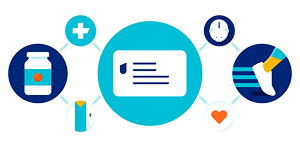Improving your eyesight is a great reason to schedule an eye exam, but it’s not the only one.
In fact, all adults — even those without a prescription for vision correction — should book a comprehensive eye and vision examination with an optometrist or ophthalmologist every 1 to 2 years, recommends Arti Shah, O.D., F.A.A.O, an optometrist at Elander Eyecare in Santa Monica, California. (Optometrists are like primary care physicians for your eyes, but they are not medical doctors. Ophthalmologists, on the other hand, are medical doctors who can perform surgery on your eyes, if needed.)
If you have a prescription, you should visit an eye doctor every year, Shah says. Same goes if you’re 40 or older. (This age group is at the greatest risk of eye diseases, according to the Centers for Disease Control and Prevention.)
“There are certain things we do, regardless of being healthy, that are just routine,” Shah says, such as an annual physical or a twice-yearly trip to the dentist. “It’s the same with an eye exam.”
Here’s why you should get your eyes checked regularly.
Typically, routine eye exams come at no additional cost to you with an insurance plan. Explore vision insurance now.
1. You can prevent vision loss
Like a colonoscopy that screens for colon cancer, an eye exam screens for a range of conditions that can lead to vision loss if left untreated.
“You could have glaucoma or macular degeneration and have no prescription change whatsoever,” Shah says. Glaucoma is a group of eye diseases that can cause pressure to build up in the eye, damaging the optic nerve. It’s one of the leading causes of blindness among Americans. Macular degeneration affects the retina, which lines the back of the eye. It occurs when the macula (part of the retina that’s responsible for clear central vision) thins with age, causing blurred vision. It’s a common eye disorder among people age 55 and older.
Because many eye diseases, such as glaucoma, may have no early symptoms, you might not notice vision changes until the condition is advanced.
“I had a patient who hadn’t had an eye exam in 10 years, and by the time they came to me, they had full-blown glaucoma,” Shah says.
Having your optometrist diagnose an eye disease early gives you a chance to slow its progression.
2. Start your kids early to develop good habits
You know you’re supposed to visit the dentist twice a year — it’s likely been part of your routine since you were a kid. So, show your kids that regular eye exams are just as important.
“If we all started eye exams when we were 6 months old, we wouldn’t be asking ‘When do I need an eye exam?’ It would just be built into our life,” Shah says.
In fact, Shah recommends that all children have at least 3 eye exams before entering first grade:
- One when they’re between 6 and 12 months old
- Another between 3 and 5 years old
- And one more right before they enter first grade
Keep in mind that young children may not recognize that their vision is bad, so just because your kid isn’t complaining doesn’t mean they don’t need glasses.
But that’s not the only reason for kids to get an eye exam. Preventing other eye conditions is also important for youngsters.
Plenty of eye conditions are common in young children and can be treated if caught early, including:
- Amblyopia, or lazy eye, which causes reduced vision in one eye
- Strabismus, or crossed eyes, in which the eyes don’t move together
Both conditions can develop in infants or young children and can easily go undiagnosed for years. However, says Shah, “Amblyopia and strabismus are very treatable, and we want to treat them at the youngest age possible, like under 7.”
Another increasingly common condition among children is myopic progression, Shah says. That’s when myopia, or nearsightedness — when things that are far away appear blurry — increases over the course of a year.
If it keeps getting worse, it can stretch the eyeball and lead to thinning of the tissue in the back of the eye (the retina), as well as tearing or even retinal detachment, Shah says. It can also increase the risk of glaucoma and early cataracts later in life, she adds.
Nearsightedness is linked to spending too much time reading or on devices like smartphones and tablets. It’s also connected to a lack of time spent outdoors, which means remote schooling and more time at home during the pandemic may have led to a rise in nearsightedness among kids, says Shah.
The onset of nearsightedness can also happen as an adult. Treatments include special contact lenses and eye drops that slow its progression, Shah says. Also, a new kind of eyeglasses are being developed to treat the condition, which may be available as soon as this year.
Ready to explore insurance plans where you live?
3. You’ll get a look at your overall health
During a typical eye exam, your optometrist may use special eye drops to dilate (or widen) your pupils. This simple procedure allows them to examine the back of the eye.
“I’m expecting to see healthy blood vessels, a healthy retina, and a healthy optic nerve,” Shah says. If there are any issues with those parts of the eye, your eye doctor will try to determine what the root cause is.
Shah notes that your optometrist may even pick up on health conditions you didn’t know you had. These could include:
- High blood pressure. Curving of the retina’s blood vessels could mean you have hypertension.
- Cancer. Certain lesions on the retina may be a sign.
- Autoimmune diseases, which occur when the immune system mistakenly attacks healthy tissue, can cause body-wide inflammation, including in the eyes.
- Diabetes.
If your optometrist suspects any of these conditions, they can refer you to a retinal specialist or the right doctor for diagnosis, treatment, and appropriate management.
Recently, Shah saw a patient who hadn’t had an eye exam in a few years. “He had this bleeding in the back of the eye — small little pinpoint areas of blood,” she recalls. He was also experiencing double vision (a possible sign of a vascular condition).
Shah referred the patient to his primary care physician, and he was diagnosed with prediabetes, an early stage of type 2 diabetes. The doctor confirmed that he had high blood pressure and prescribed medication to help control it.
That one eye exam revealed 2 underlying conditions and jump-started treatment that could help him feel — and see — better.
4. You’ll soothe your dry eyes
Are your eyes dry and irritated? Join the club. Shah estimates that about 60% of her patients suffer from dry eyes. “I have a whole protocol for my dry-eye patients,” she says. “There’s a lot we can do.”
For starters, your optometrist can determine what type of dry eye you have. These include:
- Aqueous deficient dry eye, meaning your eyes don’t produce enough watery fluid
- Evaporative dry eye, which is when the glands at the edges of your eyelids become clogged
- A combination of the 2
As Shah explains, your optometrist will use a slit lamp to check out your eyelids, lens, and tear film (a thin layer of fluid covering the surface of the eye) to determine the cause. Depending on their findings, they may recommend lifestyle changes, such as increasing your water intake or taking regular breaks from your computer. They may also suggest over-the-counter eye drops tailored to the type of dry eye you have.
For her patients with evaporative dry eye, for example, Shah recommends applying a warm compress to the area of your eye for 8 to 10 minutes, then massaging the eyelids to release some of the oils clogging the glands. For those with severe gland clogging, in-office treatments may be used, she says.
Bonus reason to get your eyes checked: Your eye doctor may ask if you also have dry mouth or dry skin — symptoms that may suggest Sjogren’s syndrome, Shah says. It’s an autoimmune disorder that can lead to blurred vision. It can also cause damage to your joints, liver, and lungs, among other areas of the body. Your eye doctor may suggest that you have bloodwork done to rule it out.
Does your health insurance not include vision benefits? A standalone vision plan can be an affordable option. Browse plans online, or call 1-844-211-7730 for more information.
Sources:
Centers for Disease Control and Prevention. "Don't Let Glaucoma Steal Your Sight!" November 24, 2020. Retrieved from https://www.cdc.gov/visionhealth/resources/features/glaucoma-awareness.html.
Centers for Disease Control and Prevention. "Vision Loss and Age." June 12, 2020. Retrieved from https://www.cdc.gov/visionhealth/risk/age.htm.
National Eye Institute. "Age-Related Macular Degeneration." June 22, 2021. Retrieved from https://www.nei.nih.gov/learn-about-eye-health/eye-conditions-and-diseases/age-related-macular-degeneration.
National Institutes of Health. "Keep an Eye on Your Eyes." May 2018. Retrieved from https://newsinhealth.nih.gov/2018/05/keep-eye-your-eyes.
Optometrist’s Network. "8 Top Natural Ways to Stop Dry Eyes." November 25, 2021. Retrieved from https://www.optometrists.org/general-practice-optometry/guide-to-eye-conditions/dry-eye/8-top-natural-ways-to-stop-dry-eyes/.
Compliance code:
UHOEYEEXA1











